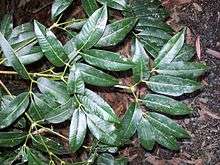Bosistoa floydii
Bosistoa floydii, commonly known as the five-leaf bosistoa[2] or five-leaved bonewood,[3] is a species of small rainforest tree that is endemic to north-eastern New South Wales. It has pinnate leaves usually with five elliptic leaflets, and panicles of tiny, creamy white flowers.
| Five-leaf bosistoa | |
|---|---|
 | |
| Bosistoa floydii in Coffs Harbour Botanic Garden | |
| Scientific classification | |
| Kingdom: | Plantae |
| Clade: | Tracheophytes |
| Clade: | Angiosperms |
| Clade: | Eudicots |
| Clade: | Rosids |
| Order: | Sapindales |
| Family: | Rutaceae |
| Genus: | Bosistoa |
| Species: | B. floydii |
| Binomial name | |
| Bosistoa floydii | |
Description
Bosistoa floydii grows as a small tree that may reach 15–20 m (49–66 ft) high and has a spreading crown. The trunk is buttressed and can reach a diameter of 75 cm (30 in), and the bark is grey. The leaves are arranged in opposite pairs on thick green or fawn branches and are pinnate, 110–280 mm (4.3–11.0 in) long on a petiole 20–50 mm (0.79–1.97 in) long. There are three to seven, usually five glossy elliptical leaflets, each 65–160 mm (2.6–6.3 in) long and 15–35 mm (0.59–1.38 in) wide on a petiolule 5–25 mm (0.20–0.98 in) long. The leaflets have prominent oli glands and a pointed tip. Appearing in October and November, the tiny flowers are arranged in panicles up to 200 mm (7.9 in) long. Each flower has five hairy sepals about 1 mm (0.039 in) long and five oval, white or creamy white petals 4–5 mm (0.16–0.20 in) long. Flowering is followed by one, or rarely two small, warty, woody, yellow-brown fruit that ripen in February.[2][3][4]
Taxonomy
Bosistoa floydii was first described in 1977 by Thomas Gordon Hartley who published the description in the Journal of the Arnold Arboretum.[5][6] The generic name Bosistoa honours the name of Joseph Bosisto, a manufacturer of essential oils. The specific epithet floydii honours the eminent Australian rainforest botanist Alexander Floyd.[4]
Distribution and habitat
Five-leaf bosistoa is restricted to subtropical rainforest in the Bellinger and Orara River areas in north-estern New South Wales, where it grows on basalt or rich alluvial soils.[2][4]
References
- "Bosistoa floydii". Australian Plant Census. Retrieved 30 June 2020.
- P. G. Richards. "Bosistoa floydii". Royal Botanic Gardens & Domain Trust, Sydney. Retrieved 30 June 2020.
- Hartley, Thomas G.; Wilson, Annette J.G. (ed.) (2013). Flora of Australia (Volume 26) (PDF). Canberra: Australian Biological Resources Study. p. 51. Retrieved 30 June 2020.CS1 maint: extra text: authors list (link)
- Floyd, A. G. (2008). Rainforest Trees of Mainland South-eastern Australia (2nd, Revised ed.). Lismore, New South Wales: Terania Rainforest Publishing. p. 351. ISBN 0-958943-67-2. Retrieved 2010-12-07.
- "Bosistoa floydii". APNI. Retrieved 30 June 2020.
- Hartley, Thomas G. (1977). "A Revision of the Genus Bosistoa (Rutaceae)". Journal of the Arnold Arboretum. 58: 428–430. Retrieved 30 June 2020.